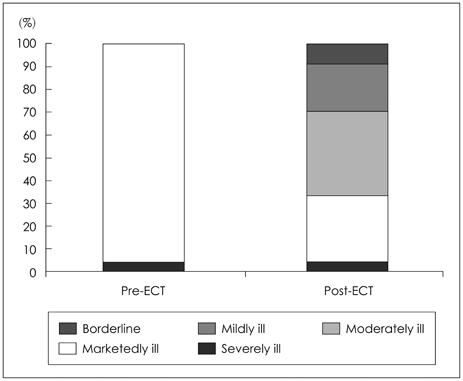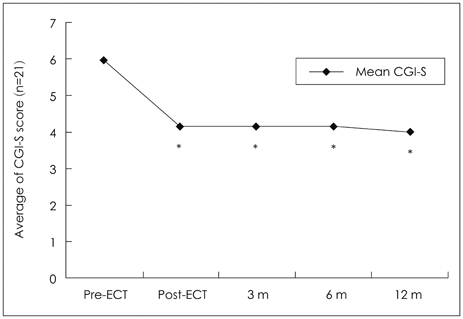J Korean Neuropsychiatr Assoc.
2012 Sep;51(5):271-276.
Electroconvulsive Therapy for Patients with Treatment-Resistant Schizophrenia Patients : A Retrospective Study
- Affiliations
-
- 1Department of Psychiatry, Inje University College of Medicine, Busan Paik Hospital, Busan, Korea. gabriel.jdu@gmail.com
Abstract
OBJECTIVES
This study analyzes the effect of electroconvulsive therapy (ECT) by predicting the factors contributing to the effectiveness of ECT and evaluating the persistency of ECT effect in patients with treatment-resistant schizophrenia.
METHODS
Using retrospective review of the charts of 24 schizophrenic inpatients who were admitted to Busan Paik Hospital between March 1, 2005 and December 31, 2009. We compared the pre-ECT Clinical Global Impression (CGI) scores and post-ECT CGI scores among these patients. We evaluated the differences in the ECT responses by sex, age, duration of illness and dose of antipsychotic agents, and investigated the rate of continuation of out-patient treatment and readmission, and the change of the CGI score for 12 months after the ECT.
RESULTS
ECT resulted in an overall clinical improvement as measured on the CGI scale. 15 (62.50%) patients were good responders, while 9 (37.50%) were poor responders. There was no significant difference between sex, age, duration of the illness, and dose of antipsychotics taken by the patient before the ECT. 21 (87.50%) patients continuously visited the outpatient department for 12 month, and 14 (66.67%) of them maintained the ECT effect with medical treatment only and without readmission.
CONCLUSION
This study showed that the ECT could be a useful treatment option for schizophrenic patients who are resistant to antipsychotics.
MeSH Terms
Figure
Reference
-
1. Cerletti U, Bini L. Un nuevo metodo di shockterapie "L' elettro-shock". Boll Accad Med Roma. 1938. 64:136–138.2. Dombrovski AY, Mulsant BH, Haskett RF, Prudic J, Begley AE, Sackeim HA. Predictors of remission after electroconvulsive therapy in unipolar major depression. J Clin Psychiatry. 2005. 66:1043–1049.3. Bundy BD, Hewer W, Andres FJ, Gass P, Sartorius A. Influence of anesthetic drugs and concurrent psychiatric medication on seizure adequacy during electroconvulsive therapy. J Clin Psychiatry. 2010. 71:775–777.4. van Waarde JA, Verwey B, van der Mast RC. Meta-analysis of initial seizure thresholds in electroconvulsive therapy. Eur Arch Psychiatry Clin Neurosci. 2009. 259:467–474.5. Fink M, Sackeim HA. Convulsive therapy in schizophrenia? Schizophr Bull. 1996. 22:27–39.6. Kinon BJ, Kane JM, Johns C, Perovich R, Ismi M, Koreen A, et al. Treatment of neuroleptic-resistant schizophrenic relapse. Psychopharmacol Bull. 1993. 29:309–314.7. Van Putten T, Marder SR, Mintz J. A controlled dose comparison of haloperidol in newly admitted schizophrenic patients. Arch Gen Psychiatry. 1990. 47:754–758.8. Kane JM, Honigfeld G, Singer J, Meltzer H. Clozapine in treatment-resistant schizophrenics. Psychopharmacol Bull. 1988. 24:62–67.9. Kho KH, Blansjaar BA, de Vries S, Babuskova D, Zwinderman AH, Linszen DH. Electroconvulsive therapy for the treatment of clozapine nonresponders suffering from schizophrenia--an open label study. Eur Arch Psychiatry Clin Neurosci. 2004. 254:372–379.10. Lehman AF, Lieberman JA, Dixon LB, McGlashan TH, Miller AL, Perkins DO, et al. Practice guideline for the treatment of patients with schizophrenia, second edition. Am J Psychiatry. 2004. 161:2 Suppl. 1–56.11. Bolwig TG. How does electroconvulsive therapy work? Theories on its mechanism. Can J Psychiatry. 2011. 56:13–18.12. Ottosson JO. Experimental studies of the mode of action of electroconvulsive therapy: Introduction. Acta Psychiatr Scand Suppl. 1960. 35:5–6.13. Heilig M, Zachrisson O, Thorsell A, Ehnvall A, Mottagui-Tabar S, Sjögren M, et al. Decreased cerebrospinal fluid neuropeptide Y (NPY) in patients with treatment refractory unipolar major depression: preliminary evidence for association with preproNPY gene polymorphism. J Psychiatr Res. 2004. 38:113–121.14. Nikisch G, Mathé AA. CSF monoamine metabolites and neuropeptides in depressed patients before and after electroconvulsive therapy. Eur Psychiatry. 2008. 23:356–359.15. Nordanskog P, Dahlstrand U, Larsson MR, Larsson EM, Knutsson L, Johanson A. Increase in hippocampal volume after electroconvulsive therapy in patients with depression: a volumetric magnetic resonance imaging study. J ECT. 2010. 26:62–67.16. Thompson JW, Weiner RD, Myers CP. Use of ECT in the United States in 1975, 1980, and 1986. Am J Psychiatry. 1994. 151:1657–1661.17. Kristensen D, Bauer J, Hageman I, Jørgensen MB. Electroconvulsive therapy for treating schizophrenia: a chart review of patients from two catchment areas. Eur Arch Psychiatry Clin Neurosci. 2011. 261:425–432.18. Greenhalgh J, Knight C, Hind D, Beverley C, Walters S. Clinical and cost-effectiveness of electroconvulsive therapy for depressive illness, schizophrenia, catatonia and mania: systematic reviews and economic modelling studies. Health Technol Assess. 2005. 9:1–156. iii–iv.19. Kim CE, Lee SY. The efficacy and safety of concurrent administration of clozapine and electroconvulsive therapy: a case report. Korean J Psychopharmacol. 2000. 11:73–77.20. Koo JW, Lee MS, Kim SH. Electroconvulsive therapy in one female with very early onset schizophrenia: a case report. Korean J Psychopharmacol. 2005. 16:416–420.21. Mayur P, Bray A, Fernandes J, Bythe K, Gilbett D. Impact of hyperventilation on stimulus efficiency during the early phase of an electroconvulsive therapy course: a randomized double-blind study. J ECT. 2010. 26:91–94.22. Kellner CH, Knapp R, Husain MM, Rasmussen K, Sampson S, Cullum M, et al. Bifrontal, bitemporal and right unilateral electrode placement in ECT: randomised trial. Br J Psychiatry. 2010. 196:226–234.23. Guy W. Rush A, First M, Blacker D, editors. Clinical Global Impressions Scale. Handbook of Psychiatric Measures. 2008. 2nd ed. Wasington, DC: American Psychiatric publishing;90–92.24. Elkis H. Elkis H, Meltzer HY, editors. History and Current Definitions of Treatment-Resistant Schizophrenia. Therapy-Resistant Schizophrenia. 2010. Basel: Karger;1–8.25. König P, Glatter-Götz U. Combined electroconvulsive and neuroleptic therapy in schizophrenia refractory to neuroleptics. Schizophr Res. 1990. 3:351–354.26. Chanpattana W, Sackeim HA. Electroconvulsive therapy in treatment-resistant schizophrenia: prediction of response and the nature of symptomatic improvement. J ECT. 2010. 26:289–298.27. O'Connor MK, Knapp R, Husain M, Rummans TA, Petrides G, Smith G, et al. The influence of age on the response of major depression to electroconvulsive therapy: a C.O.R.E. Report. Am J Geriatr Psychiatry. 2001. 9:382–390.28. Hustig H, Onilov R. ECT rekindles pharmacological response in schizophrenia. Eur Psychiatry. 2009. 24:521–525.
- Full Text Links
- Actions
-
Cited
- CITED
-
- Close
- Share
- Similar articles
-
- The Efficacy and Safety of Concurrent Administration of Clozapine and Electroconvulsive Therapy: A Case Report
- Efficacy of Asenapine in Schizophrenia Resistant to Clozapine Combined with Electroconvulsive Therapy: A Case Report
- The effect of electroconvulsive therapy on the cerebrospinal fluid 5-HT and 5-HIAA concentrations in the chronic treatment-resistant schizophrenia
- Combined Clozapine and Electroconvulsive Therapy in a Japanese Schizophrenia Patient: A Case Report
- The Effects of Continuation-Maintenance Electroconvulsive Therapy on Reducing Hospital Re-Admissions in Patients with Treatment-Resistant Schizophrenia



